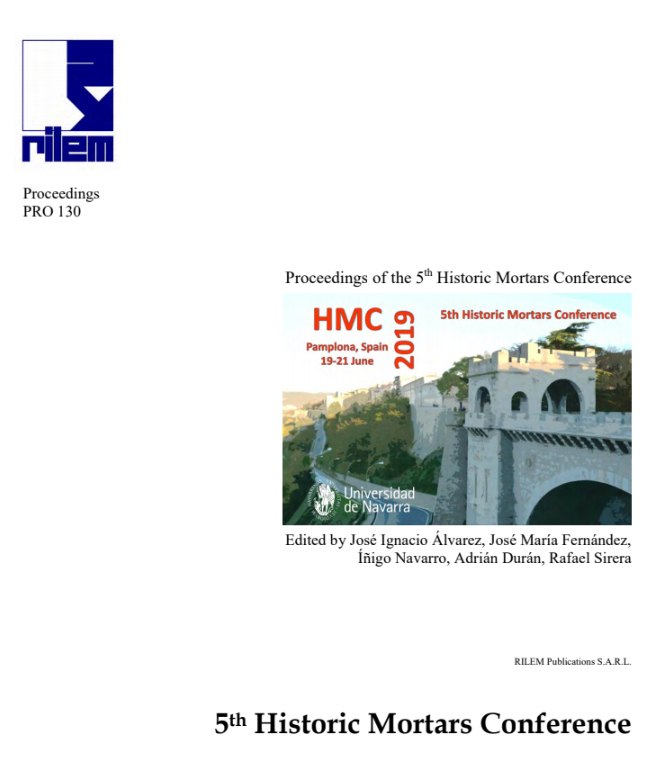Publications
Proceedings pro130 : 5th Historic Mortars Conference
HMC’s are fully consolidated as a one-of-a kind forum to deal with historic mortars, renders and grouts, the variety of their compositions and raw materials, diverse methodologies of study, archeological sites, dating, preservation, durability, obtaining of repair materials and testing methods, consolidation, and even the upgrade of the repair mortars by nano-technology. This HMC 2019 gathers 165 scientific and technical high-levelled contributions of participants from the five continents. Up to twelve different topics are displayed in the Conference Programme, thus emphasising the wide range of approaches that enrich the final outcome of the event. The profitable exchange between the science advances and the practice taking place during the Conference is supported by contributions focused on a more theoretical scientific point of view combined with those works more oriented towards real applications, including case studies, assessment of the state of conservation of some ancient materials or monitoring of the effectiveness of some rehabilitation procedures and repair materials.
Contents
|
Preface Author(s): Prof. José Ignacio Álvarez |
Pages: 1-1 |
Topic 1
|
Topic 1: Earth-based plasters and mortars on archaeology and historic constructions Author(s): - |
Pages: 3-3 |
|
Earth-based and current plasters: assessment of efficiency and contribution to indoor air quality Author(s): Tânia Santos, Maria Idália Gomes, Flávia Coelho, Paulina Faria |
Pages: 5-20 |
|
Earth-based plasters: the influence of clay mineralogy Author(s): José Lima, Paulina Faria, António Santos Silva |
Pages: 21-35 |
|
Rescuing the manufacturing process of traditional mortars present on XIX-century earthen buildings in Brazil Author(s): Andrea Cavicchioli, Isabela Ferreira Sodré dos Santos, João Guilherme Kimura Moreira, Lucy Gomes Sant'Anna |
Pages: 36-50 |
|
Assessment of adhesive strength of an earth plaster on different substrates through different methods Author(s): Paulina Faria, José Lima, João Nabais, Vitor Silva |
Pages: 51-64 |
|
Similar appearance of mortar and brick masses in Algiers Casbah houses during the Ottoman period (16th- early 18th centuries) Author(s): Semha Bernou, Tsouria Kassab, Rosa Bustamante, Francisco Fernández |
Pages: 65-79 |
|
Macroscopic high resolution techniques to the characterization the mortars structures in the Sé-Cathedral´s archaeological complex in Idanha-a-Velha (Portugal) Author(s): Pablo Guerra-García, Jorge Morín de Pablos, Isabel Sánchez Ramos |
Pages: 80-92 |
Topic 2
|
TOPIC 2: USE OF NANOTECHNOLOGY FOR HIGH PERFORMANCE MORTARS Author(s): - |
Pages: 93-93 |
|
Evaluation of the influence of nano-SiO2 and nano-Al2O3 on the physico-mechanical properties and microstructure of calcareous clay Author(s): Eirini-Chrysanthi Tsardaka, Maria Stefanidou |
Pages: 95-107 |
|
The use of nanoparticles to improve the performance of restoration mortars Author(s): Beatriz Menéndez, Dita Frankeová, José Diaz, Radek Ševčík, Petra Macová, Mouna Faiz, Zuzana Slížková |
Pages: 108-120 |
|
Evaluation of SiO2 nanoparticles as additive for lime mortars: changes in the microstructure and mechanical properties Author(s): María del Mar Barbero-Barrera, Aranzazu Sierra Fernández, Duygu Ergenc , Luz Stella Gomez Villalba, Rafael Fort |
Pages: 121-131 |
|
Enhancing clay mortars’ properties Author(s): A. Karozou, M. Stefanidou |
Pages: 132-143 |
|
Study of the role of different nanoparticles in lime pastes Author(s): Eirini-Chrysanthi Tsardaka, Maria Stefanidou |
Pages: 144-154 |
|
Active photocatalytic-superhydrophobic coating with TiO2/ZnO nano-heterostructures for lime mortars Author(s): Alessandro Speziale, Jesús Fidel González-Sánchez, Íñigo Navarro-Blasco, José M. Fernández, José I. Alvarez |
Pages: 155-168 |
Topic 3
|
Topic 3: Gypsum-based plasters and mortars in historical constructions Author(s): - |
Pages: 169-169 |
|
Study of properties of gypsum plasters from Araripe’s Pole for application in restoration mortars Author(s): Fernanda Cavalcanti Ferreira, Jose Getulio Gomes de Sousa, Arnaldo Manoel Pereira Carneiro |
Pages: 171-185 |
|
Characterization of Gypsum Renders in the Paris Region and Determination of the Traditional Fabrication Process Author(s): Jean Ducasse-Lapeyrusse, Véronique Vergès-Belmin |
Pages: 186-200 |
|
The use of stucco-marble to restore veined polished limestone. The case of the pavement in the major sacristy of the Cathedral of Seville Author(s): Antonio González Portillo, Maria Teresa Freire |
Pages: 201-210 |
|
Stucco marble in the Portuguese architecture: first insights in mineralogical, physical and mechanical properties Author(s): Maria Teresa Freire, António Santos Silva, Maria do Rosário Veiga |
Pages: 211-225 |
|
Clay and gypsum mortars used during antiquity in Cyprus Author(s): Maria Philokyprou |
Pages: 226-236 |
|
Physical- mechanical comparison of the traditional gypsums from Albarracín and Pallars Author(s): David Osmar Batres Hernández, Antonia Navarro Ezquerra, Joan Ramon Rosell Amigó |
Pages: 237-247 |
|
Detailed studies of gypsum plasters from the Ishrat Khana Mausoleum in Samarkand, Uzbekistan Author(s): Steffen Laue |
Pages: 248-258 |
Topic 4
|
Topic 4: Functional mortars for the conservation of historic and modern cultural heritage structures Author(s): - |
Pages: 259-259 |
|
Use of natural zeolite aggregate in restoration lime renders Author(s): Martin Vyšvařil, Patrik Bayer, Tomáš Žižlavský, Pavla Rovnaníková |
Pages: 261-272 |
|
Fibre reinforced mortars for cultural heritage protection Author(s): Miloš Drdácký, Dagmar Michoinová |
Pages: 273-282 |
|
Comparative evaluation of the morphological and rheological characteristics of nanolime dispersions for the consolidation of architectural monuments Author(s): Anastasia Michalopoulou, Elisavet Michailidi, Evangelos Favvas, Noni-Pagona Maravelaki, Vassilis Kilikoglou, Ioannis Karatasios |
Pages: 283-295 |
|
Autogenic vs. autonomic self-healing process in conservation mortars with crystalline admixture Author(s): Maria Amenta, Matina Papaioannou, Marios S. Katsiotis, Dimitris Gournis, Vassilis Kilikoglou, Ioannis Karatasios |
Pages: 296-306 |
|
Addressing safety and durability requirements of architectural heritage by developing functional conservation mortars Author(s): Ioannis Karatasios, Zoi S. Metaxa, Stavros K. Kourkoulis, Nikolaos D. Alexopoulos, Vassilis Kilikoglou |
Pages: 307-318 |
|
Self- healing lime-based mortars using biological mechanisms and microvascular networks Author(s): Cristina De Nardi, Magdalini Theodoridou, Philip Sim, Michael Harbottle, Anthoby D. Jefferson |
Pages: 319-329 |
|
Hydrophobized lime grouts prepared with microsilica and superplasticizers Author(s): Jesús Fidel González-Sánchez, Íñigo Navarro-Blasco, Adrián Duran, Rafael Sirera, José M. Fernández, José Ignacio Álvarez |
Pages: 330-345 |
|
Photoactive Fe-TiO2 Lime Plasters for Building Protection Author(s): Chrysi Kapridaki, Nikolaos Xynidis, Nikolaos Xekoukoulotakis, Nikolaos Kallithrakas-Kontos, Noni Maravelaki |
Pages: 346-358 |
|
Lime-based rendering mortars with photocatalytic and hydrophobic agents: assessment of the water repellency and biocide effect Author(s): Jesús Fidel González-Sánchez, Burcu Taşcı, Guillermo Martínez de Tejada, José M. Fernández, Íñigo Navarro-Blasco, José Ignacio Alvarez |
Pages: 359-372 |
|
SRG, Steel Reinforced Grout for strengthening masonry structures: from tests to applications Author(s): Paolo Casadei, Paolo Girardello |
Pages: 373-382 |
Topic 5
|
Characterization of historic mortars and masonry structures. Sampling and test methods Author(s): - |
Pages: 383-383 |
|
Calcite or quartz powder as aggregate of Roman plasters (Lombardy, Italy) Author(s): Roberto Bugini, Luisa Folli |
Pages: 385-395 |
|
Analytical and chromatic characterization of the interior walls finishes in the Batlló House of Gaudí in Barcelona. A surprising discovery Author(s): Àgueda Serra, Joan Casadevall |
Pages: 396-409 |
|
Roman mortars of floor substrates and walls from Arroyo de la Dehesa de Velasco site: petrographic and mineralogical characterization Author(s): Ainhoa Alonso-Olazabal,, Luis Ángel Ortega, Ma Cruz Zuluaga, Graciela Ponce, Javier Jiménez Echevarría, Carmen Alonso Fernández |
Pages: 410-423 |
|
Provenance study of raw materials used for lime making at Prague Castle during medieval times Author(s): Petr Kozlovcev, Jan Válek, Olga Skružná |
Pages: 424-438 |
|
Interpretation of scientific data derived from analytical techniques used in the characterization of Roman mortars Author(s): Petr Kozlovcev, Jan Válek, Olga Skružná |
Pages: 439-452 |
|
Petrography of Historic Mortar Materials: Polarising Light Microscopy as a Method for Characterising Lime-Based Mortars Author(s): Kristin Balksten,Bo Nitz, John J. Hughes,Jan-Erik Lindqvist |
Pages: 453-467 |
|
Roman vs. medieval crushed brick lime mortars: A comparative study Author(s): Martin Schidlowski, Tobias Bader, Anja Diekamp |
Pages: 468-481 |
|
A map is worth a thousand pictures: Using FTIR-imaging to analyze petrographic thin sections of historical and experimental mortar Author(s): Anthony J. Baragona, Marta Anghelone, Johannes Weber |
Pages: 482-494 |
|
Characterisation of concrete structures along the Reschen frontier, South Tyrol, Italy Author(s): Tobias Bader, Anja Diekamp |
Pages: 495-505 |
|
Chemical, mineralogical and hydraulic characteristics of Roman mortars in Turkey Author(s): Burcu Taşcı,Hasan Böke |
Pages: 506-515 |
|
DB-HERITAGE: A database of mortars composition and characteristics Author(s): António Santos Silva, Rodrigo Giollo, Maria João Correia, Maria do Rosário Veiga, Paulina Faria |
Pages: 516-528 |
|
Algarve vernacular architecture facade ornaments: chemical and mineralogical characterization Author(s): Marta Santo, António Santos Silva, Rosário Veiga |
Pages: 529-543 |
|
Characterisation methodology for lime based materials – A case study of the Rajagopuram of Pundarikaksha temple in Tamil Nadu, India Author(s): Divya Rani and Manu Santhanam |
Pages: 544-554 |
|
Sampling cataloging methodology procedures for the conservation of historical colours in urban landscapes Author(s): Isolina Díaz-Ramos, Jorge Manzano Cabrera |
Pages: 555-564 |
|
Mineralogical characterization of historical cement-based mortars from Rupnik military fortification line Author(s): Petra Štukovnik, Janez Peter Grom, Marjan Marinšek, Violeta Bokan Bosiljkov |
Pages: 565-575 |
Topic 6
|
Historic production, processing and application of mortars, renders and grouts. Lime technologies Author(s): - |
Pages: 577-577 |
|
Warm applied Mortar (WAM) – An insight into the historical technique of “Heiße Speis” and its use for renders Author(s): Robert Wacha, Farkas Pintér |
Pages: 579-584 |
|
Blast furnace slag in historic mortars of Bergslagen, Sweden Author(s): Jan Erik Lindqvist, Kristin Balksten, Birgit Fredrich |
Pages: 585-595 |
|
Composition and Technology of the 17th Century Stucco Decorations at Červená Lhota Castle in the Southern Bohemia Author(s): Jan Válek, Olga Skružná, Petr Kozlovcev, Dita Frankeová, Petra Mácová, Alberto Viani, Ivana Kumpová |
Pages: 596-613 |
|
Hot applied lime mortar – assessment of a traditional technique used in modern restoration Author(s): Thomas Köberle, Matthias Zötzl, Alexander Fenzke, Heiner Siedel |
Pages: 614-627 |
|
Preliminary research on potential raw material sources for dolomitic lime mortars at St. John’s convent at Müstair, Switzerland Author(s): Giovanni Cavallo, Marta Caroselli, Albert Jornet, Patrick Cassitti |
Pages: 628-641 |
|
A Mortar Maker’s guide to evolving mortar specifications in 18th and 19th C France and England and their implications today Author(s): Lucie Fusade |
Pages: 642-652 |
Topic 7
|
Mortars in archaeological sites. Construction history. Archaeometry Author(s): - |
Pages: 653-653 |
|
Characterization and durability analysis of coral stones in a marine environment Author(s): Swathy Manohar, Manu Santhanam |
Pages: 655-664 |
|
Technical analysis on materials and characteristics of mortar-based compounds in Roman and Late antique Aquileia (Udine, Italy). A preliminary report of the results Author(s): Simone Dilaria, Michele Secco, Jacopo Bonetto, Gilberto Artioli |
Pages: 665-680 |
|
Fernandina old Wall of Lisbon – Characterization towards its preservation Author(s): Leandro Gomes, Paulina Faria, Vitor Silva, António Santos Silva |
Pages: 681-694 |
|
M.N.I.A.R. techniques of macroscopic characterization from the colorimetry and chromatographies analysis applied to the mortars in the archaeological site of Los Hitos (Arisgotas, Toledo, Spain) Author(s): Pablo Guerra-García, Jorge Morín de Pablos, Isabel Sánchez Ramos |
Pages: 695-712 |
|
Analysis of mortar samples from the Church of the Saints Sergius and Bacchus at Umm as-Surab (Jordan) Author(s): Piero Gilento, Cecilia Pesce, Giovanni Pesce |
Pages: 713-726 |
|
Characterisation of Roman Mortar from the Archaeological Site of Mirobriga Author(s): Alvin Sern Hao Chua, Cristina Galacho, Patrícia Moita, José Carlos Quaresma |
Pages: 727-742 |
|
Insights into Carolingian construction techniques – results from archaeological and mineralogical studies at Müstair Monastery, Grisons, Switzerland Author(s): Marta Caroselli, Christine Bläuer, Patrick Cassitti, Giovanni Cavallo, Irka Hajdas, Sophie Hueglin, Hans Neukom, Albert Jornet |
Pages: 743-757 |
|
Animal, Vegetable or Mineral? Characterising shell-lime, maerl-lime and limestone-lime mortar evidence from the Late Norse and Medieval site of Tuquoy, Orkney Author(s): Mark Thacker, John Hughes, Nic Odling3 |
Pages: 758-777 |
Topic 8
|
Topic 8: Dating of historic mortars Author(s): |
Pages: 779 |
|
An Ecology of Castle Construction: geoarchaeology, archaeobotany & radiocarbon analysis in the ecotone of Lochindorb Castle Author(s): Mark Thacker |
Pages: 781-799 |
|
Characterization of historic mortars: techniques used to establish a construction chronology. Case study: “Aragoneses’ Mill” as it belongs to popular architectural heritage Author(s): Esther Moreno Fernández, Javier Pinilla Melo, Francisco González Yunta, Alberto Sepulcre Aguilar, Ignacio Lombillo Vozmediano, Yosbel Boffill Orama |
Pages: 800-815 |
Topic 9
|
Topic 9: Natural and Roman cement mortars Author(s): |
Pages: 817 |
|
From marlstone to rotary kilns – the early development of Portland cements in Central Europe Author(s): Farkas Pintér, Christophe Gosselin, Thomas Köberle, István Vidovszky, Johannes Weber |
Pages: 819-832 |
|
European natural cements - their key technical properties under standardised conditions Author(s): David Hughes, Johannes Weber, Vincenzo Starinieri, Farkas Pinter , Christophe Gosselin, Steven Feldman, Cecilia Pesce |
Pages: 833-847 |
|
Restoration techniques using 1930’s Portland cements at Porte de l’Est in the Roman city-wall of Aventicum, Switzerland Author(s): Christophe Gosselin, Noé Terrapon |
Pages: 848-861 |
|
Drying Shrinkage of Historic Portland Cements: Factors to be Considered for Successful Repair Author(s): Simeon Wilkie, Thomas Dyer |
Pages: 862-876 |
|
Repairs to Historic Concrete Pavement at Jacob Riis Park Utilizing Natural, Roman and Portland Cements Author(s): Michael P. Edison |
Pages: 855-877 |
|
Methodology of identification of natural and historic Portland cements. Application and study in mortars of Madrid and Barcelona Author(s): Cristina Mayo Corrochano, Judith Ramírez-Casas, David Sanz Arauz, Antonia Navarro Ezquerra, Juan Ramon Rosell Amigo |
Pages: 886-890 |
|
The use of mortars in Palau Güell by Antoni Gaudi Author(s): Ricardo Gomez-Val, Judith Ramirez-Casas, Antonia Navarro-Ezquerra |
Pages: 901-913 |
|
When Portland cement meets natural cement Author(s): Elisabeth Marie-Victoire, Myriam Bouichou |
Pages: 914-927 |
Topic 10
|
Topic 10: Conservation issues concerning mortars, plasters, renders and grouts. Diagnosis. Decay and damage mechanisms. Case studies Author(s): |
Pages: 929 |
|
Decorative renders simulating stone of middle 20th century in the region of Lisbon Author(s): Maria do Rosário Veiga, António Santos Silva, Cláudia Martinho, Paulina Faria |
Pages: 931-943 |
|
The analysis of the proportion of mortar for Japanese roof tile (Ibushikawara) in Taiwan by applying of Taguchi Method Author(s): Mei-Tsu Hsu , Bing-Sheng Yu |
Pages: 944-958 |
|
Evolution of mortars composition and characteristics during the 20th century– Study of Portuguese buildings awarded with Architecture Valmor Prize Author(s): Luís Almeida, António Santos Silva, José Mirão, Maria do Rosário Veiga |
Pages: 959-972 |
|
Practical application of lime-pozzolan mortars to damp masonry Author(s): Dita Frankeová, Dana Janotová, Zuzana Slížková |
Pages: 973-985 |
|
The use of dolomitic lime in mortar samples from a 15th-century buttress of York Minster (York, UK) Author(s): Cecilia Pesce, Alick Leslie, Alison Henry, John David, Giovanni Pesce |
Pages: 986-996 |
|
The Restoration of the church of Our Lady of the Assumption, Dauis, Bohol, Philippines Author(s): Engr. Jim Franklin O. Kalaw, Engr. Raul Y. Naguit Jr. |
Pages: 997-1007 |
|
Digital image analysis as basis for the evaluation of repair mortars in architectural conservation Author(s): C. Kaiser, L. Oetinger, R. Killian |
Pages: 1008-1020 |
Topic 11
|
Topic 11: Preservation. Consolidation materials and techniques. Development of new products. Preventive conservation Author(s): |
Pages: 1021 |
|
Frost resistance of reproduced mosaic mortars Author(s): Pavla Bauerová, Pavel Reiterman, Eva Vejmelková, Martin Keppert |
Pages: 1023-1031 |
|
Preliminary results on the use of ammonium phosphate solutions for the consolidation of lime-based mortars Author(s): Enrico Sassoni, Cesare Pizzigatti, Elisa Franzoni |
Pages: 1032-1039 |
|
Comparative study of ethyl silicate versus acrylic resin consolidation of wall painting with high water and salts contents: a case study at the Chapter Hall of Chartres cathedral Author(s): Laura Normand, Stéphanie Duchêne, Véronique Vergès-Belmin, Claire Dandrel, David Giovannacci, Witold Nowik |
Pages: 1040-1055 |
|
Comparative analysis of permeability values of traditional aerial lime mortars for preventive conservation Author(s): Ana González-Serrano, Reyes Rodríguez-García, Esther Ontiveros-Ortega |
Pages: 1056-1067 |
|
Challenges and strategies of preventive conservation in places of worship – Church of Nossa Senhora de Guadalupe case study Author(s): Ana González-Serrano, Reyes Rodríguez-García, Esther Ontiveros-Ortega |
Pages: 1068-1084 |
Topic 12
|
Topic 12: Repair mortars and grouts. Requirements and design. Compatibility issues. Durability and effectiveness. Repair mortars: Adequacy of testing procedures Author(s): |
Pages: 1085 |
|
Effects of natural zeolite addition to lime based render layers for restoration of historical buildings Author(s): Marina Aškrabić, Dimitrije Zakić, Aleksandar Savić, Ljiljana Miličić |
Pages: 1087-1098 |
|
Use of ultrafine mafic rocks for the enhancement of carbonation reaction in lime renders Author(s): Loucas Kyriakou, Ioannis Rigopoulos, Ioannis Ioannou |
Pages: 1099-1111 |
|
Microstructure of lime pastes with the addition of vegetable oils Author(s): Cristiana Nunes, Alberto Viani, Kateřina Mlsnová, Dita Frankeová, Petra Mácová |
Pages: 1112-1124 |
|
Improvements to Water, Salt-Scaling and Freeze-Thaw Resistances Of Historic Mortar Replication Mixes Author(s): Michael P. Edison, Chad Lausberg |
Pages: 1125-1141 |
|
Formulated lime mortars as a sustainable practice for Built Heritage conservation in Mexico Author(s): Marlene Sámano Chong |
Pages: 1142-1155 |
|
The impact of elevated temperatures on the properties of lime- based mortars Author(s): Vasiliki Pachta, Sofia Triantafyllaki, Maria Stefanidou |
Pages: 1156-1165 |
|
Characterization and compatibility assessment of commercial stone repair mortars Author(s): Barbara Lubelli, Timo G. Nijland, Rob P.J. van Hees |
Pages: 1166-1179 |
|
Impact of aggregates on fresh mortars’ properties Author(s): Ana Rita Santos, Maria do Rosário Veiga, António Santos Silva, Jorge de Brito |
Pages: 1180-1194 |
|
NHL-based plasters and renders – Assessing the influence of mixing method on workability and hardened mortar properties Author(s): Frowin Ruegenberg, Martin Schidlowski, Tobias Bader, Anja Diekamp |
Pages: 1195-1214 |
|
Lime-based grouts for architectural surface repair. Comparison of their performance by using laboratory and field test methods Author(s): Vasiliki Pachta, Ioanna Papayianni, Thomas Spyriliotis |
Pages: 1215-1224 |
|
Evaluation of the fresh state properties of lime-based grouts through inter-laboratory comparative testing Author(s): Vasiliki Pachta, Davide Gulotta, Jan Valek, Ioanna Papayianni |
Pages: 1225-1237 |
|
Lime-pozzolan injection grouts with ovalbumin and ethanol added as water-reducing agents: grout design and assessment of the mineralogical evolution Author(s): Chiara Pasian, Michele Secco, Francesca Piqué, Gilberto Artioli, Sharon Cather |
Pages: 1238-1250 |
|
Limestone-filled, hydraulic-lime mortars for historic and traditional fabrics Author(s): Marwa Aly, Sara Pavía |
Pages: 1251-1266 |
|
Comparing the moisture permeability of limecrete and concrete floor slabs Author(s): Grace A. Phillips, Kevin Briggs, Iain McCaig, Richard J. Ball |
Pages: 1267-1278 |
|
Impact of guar gum and chitosan ethers on physico-mechanical properties and durability of natural hydraulic lime mortars Author(s): Tomáš Žižlavský, Martin Vyšvařil, Patrik Bayer, Pavla Rovnaníková |
Pages: 1279-1290 |
|
Diethyl oxalate-based microgrouts in calcium carbonate systems: formulation, field testing and mineralogical characterization Author(s): J. Herrick Porter, C. Pasian, M. Secco, M. Salameh, N. Debono |
Pages: 1291-1305 |
|
Influence of the substrate on the mechanical characteristics of the applied mortars Author(s): Isabel Torres, Dora Silveira, Inês Flores-Colen, Rafael Pinto, Gina Matias |
Pages: 1306-1315 |
|
Lime Based Mortars. Relationships between Composition Parameters and Mechanical Strength Author(s): Ioanna Papayianni, Dimitris Papadimitriou |
Pages: 1316-1324 |
|
Investigating differences in the performance of lime-based mortars Author(s): Ioanna Papayianni, Vasiliki Pachta, Emmanouela Berberidou, Maria Kalogirou |
Pages: 1325-1332 |
|
A grout and mortar system for fine cracks and shallow surface fills in Carrara marble Author(s): Andrew Thorn |
Pages: 1333-1345 |
|
Evaluation of the rheological behaviour of a natural additive of vegetal origin in restoration lime mortars as an ecological and sustainable alternative Author(s): N. Guasch-Ferré, M.R. Veiga, T. Díaz Gonçalves, M. T. Doménech-Carbó, J.L. Prada, |
Pages: 1346-1360 |
|
The initial reactions of lime-pozzolan pastes for conservation of masonry Author(s): Tuğçe Büşra Su, Richard J Ball, Juliana Calabria Holley |
Pages: 1361-1373 |
|
Efficiency of field test methods for evaluation of non-structural injection grouts in Slovenian conservation practice Author(s): Andreja Padovnik, Violeta Bokan Bosiljkov |
Pages: 1374-1387 |






